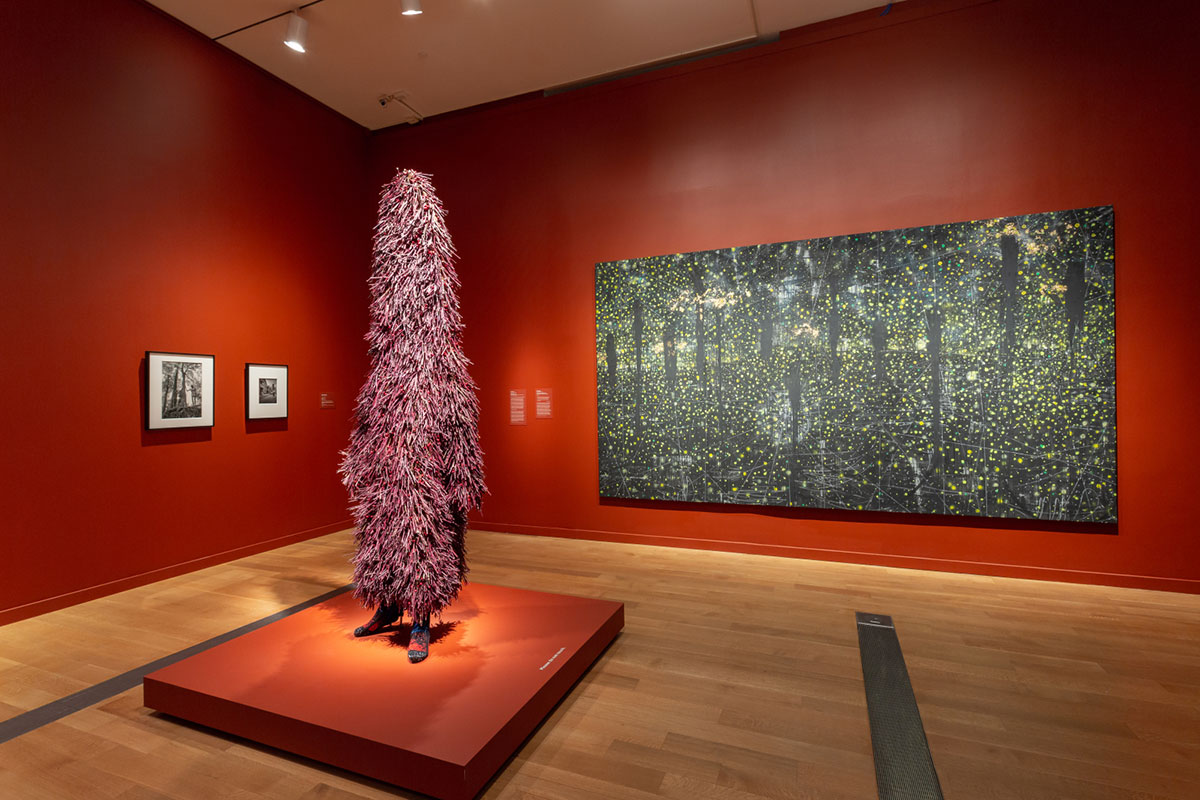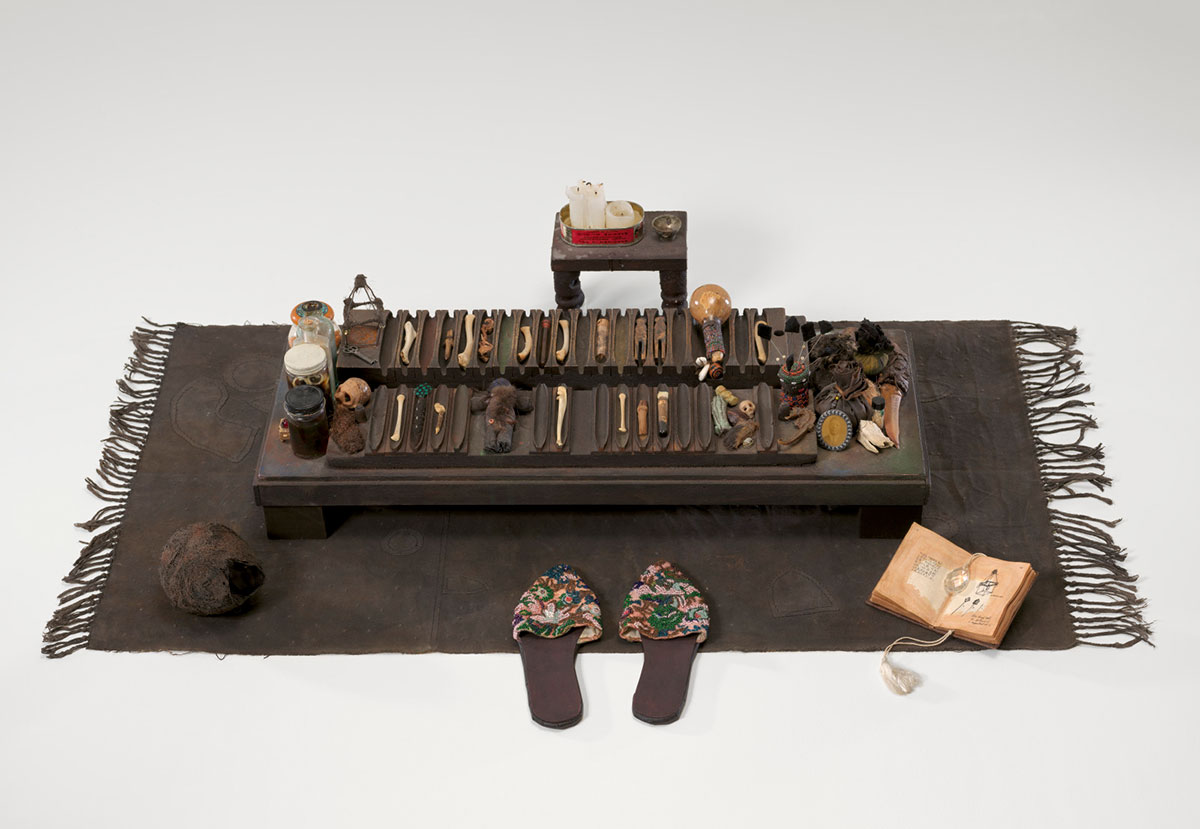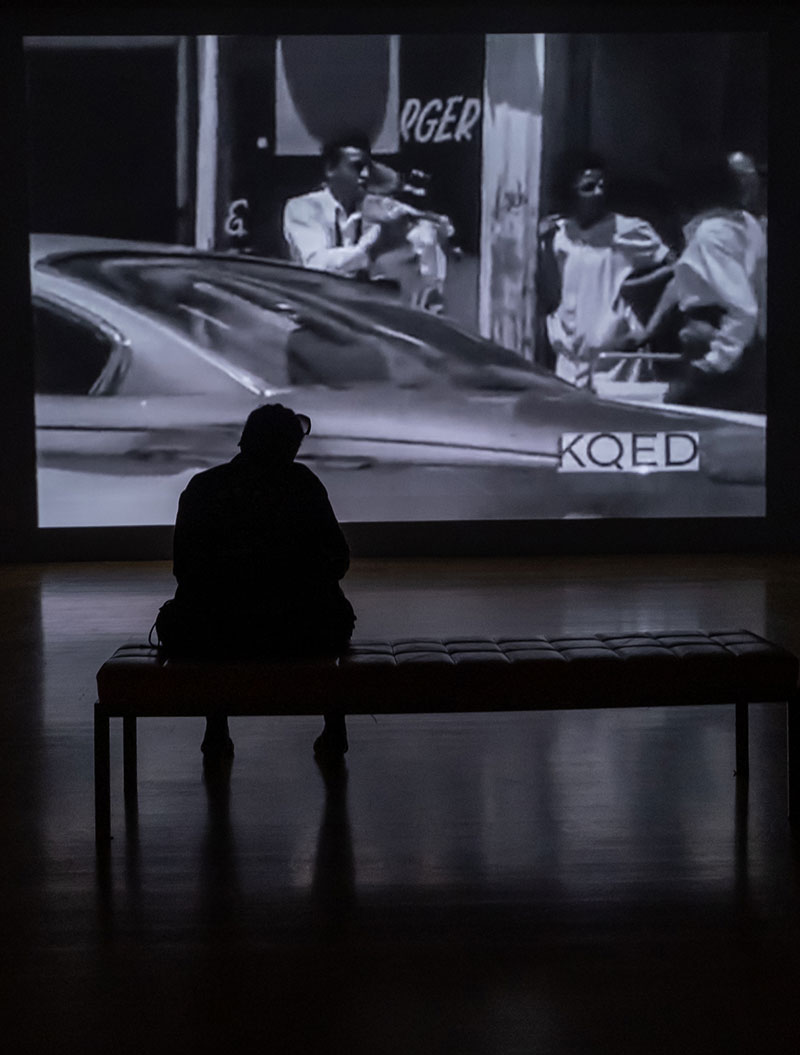This summer, the Virginia Museum of Fine Arts had five “Teen Terns” join the Education and Marketing teams during the months of June, July, and August. Teen Ternships are paid internship opportunities for Richmond-area high school students who have previously participated in VMFA’s Museum Leaders in Training (MLiT). This year, we had an additional Teen Tern join us who had previously participated in the Girls For A Change Action Team at VMFA. As part of the Teen Ternship, students visited The Dirty South: Contemporary Art, Material Culture, and the Sonic Impulse and spent time observing an object of their choice. Students then reflected on their reactions to the exhibition and wrote a personal response about the object that they spent time with. Here are excerpts from their interpretative responses:
Mikal Banks (Rising Junior | The Steward School) reflects on
Let Them Be Children by Deborah Roberts

Of the more than 140 works of art featured in VMFA’s current exhibition The Dirty South: Contemporary Art, Material Culture, and the Sonic Impulse, it was near impossible for me to choose but one favorite. Each work of art surrounding me, as I walked in awe through the rich, red halls of the exhibition, had its own unique and captivating story. However, as I drew near the end of the exhibition, my attention was caught in a mesmerizing trance by one work of art in particular. Let Them Be Children, by American contemporary artist Deborah Roberts, explores the immense impact social pressures have on individuals and communities, as well as the challenges, often overlooked and suppressed by society, faced by young Black children as they develop their identities. Using vivid acrylic paints, pastels, ink, and gouache on a large white canvas, Roberts depicts a group of Black children with disproportionate arms and legs, jutting out at what seems to be random angles to suggest childlike innocence and playfulness. However, as I took a closer look, I noticed that, with a few subtle gestures and expressions of wariness, Roberts reminds the audience of the social strains placed on Black children, causing them to grow up much too quickly. As I took an even closer look, I noticed that toward the right side of the canvas a group of children peer warily at the left group of children’s energized, carefree movements. However, from the right group of children extends a hand to the left, hinting at the group’s internal desire to join and be granted permission by society to just be children. Yet, they are held back by their need, induced by societal pressures, to grow up much too quickly. While each and every work of art displayed in The Dirty South exhibition has its own deeper meaning of bringing the art of African and African American artists to light, I feel this work of art, with its vibrant colors and massive size, is an outcry from Roberts to the world to just “Let Them Be Children.”
Mikaila Pegram (Incoming Freshman | Virginia Commonwealth University) reflects on
The Seasons: Summer by Michi Meko

This artwork attracted my attention the moment I walked into the exhibition. Meko is a fisherman and camping enthusiast. His work often addresses Black bodies in the wilderness, and he brings the connection of race into this piece. The Seasons: Summer is part of a series representing the four seasons, including the bright southern summer sky full of lightning bugs. Meko’s recent art has shown the African American experience of navigating through public places while remaining seen or heard within those spaces. First, looking at this painting, I viewed it as a summer night with lighting bugs and dark figures, but the meaning behind it is a deep and complex story. The lighting bugs surround the Black figures representing a person of color feeling outnumbered everywhere you go, for example, when trying to achieve new things for yourself or moving up the ladder in life. For me, this piece represents how much people of color have to work for everything earned because nothing is given. The Dirty South: Contemporary Art, Material Culture, and the Sonic Impulse is about Black history and what we have endured as a people. For me, The Seasons: Summer is connected to that because it shows people of color trapped in a white person’s society and trying to survive.
Malena Lo Prete (Rising Senior | Monacan High School) reflects on
She Kept Her Conjuring Table Very Neat by Renée Stout

Although the juxtaposition of modernity and history can be found in most pieces in The Dirty South: Contemporary Art, Material Culture, and the Sonic Impulse, there is still a range in that balance, and some of the exhibition’s works lean more on the side of modernity—which is not the case for all the works on view. For example, Renée Stout’s She Kept Her Conjuring Table Very Neat is more based in tradition and its relationship to the artist; what makes it still within the theme has more to do with the context of the piece. The installation is almost a snapshot into a larger scene: shoes placed neatly on a brown mat, and a low table filled with intricate objects also on top of the simple brown mat. This piece absolutely resonates with power, mystique, and history. However, it was made in the 1990s, which brings it into the lens of the time and the contrast between the ancient aspects of the installation. The melding together of the context of Stouts’s work and the subject matter (both explained and perceived) make this piece a perfect example of the theme of the “Dirty South.”
Ajai Upadhyaya (Rising Senior | Monacan High School) reflects on
Love Is the Message, The Message Is Death by Arthur Jafa

Mississippi native Arthur Jafa is one of the most renowned voices in cinematography of the past decade. The Hirshhorn Museum, Museum of Contemporary Art, and now the Virginia Museum of Fine Arts have presented his room-shaking videos. Set to the tune of Kanye West’s Ultralight Beam, a modern hip-hop song with reminiscent old-school heavy drums and chorus, the video persuaded me to reflect upon what I just viewed in rooms before. The viewer also looks back on their life and the emotions they experienced in The Dirty South: Contemporary Art, Material Culture, and the Sonic Impulse. Jafa’s piece features powerful videos from the independent and signed, when sitting among the fleeting Kelly Price vocals, it is impossible for a viewer to not reflect upon the previous pieces of art in The Dirty South exhibition. Highlighting Black artists over the course of 100 years, the exhibit connects the love for hip-hop in the South to the rest of the world. To some viewers, this video may entail thoughts one was not prepared to think about, but I believe that this was in fact Jafa’s purpose to promote a higher piece of art. Seen very early in Love Is the Message, The Message Is Death, Jafa’s combination of lighthearted club dancing clips to disturbing police brutality persuades the viewer to sway in their seats. As this piece can be heard on the loudspeakers as you approach it, the anticipation builds as viewers walk through the dimly lit hallway. I believe this piece is crucial and especially important as a closing statement to The Dirty South exhibition because between the silence and the black screens between the stunning visuals, it tells the viewers to be kind. To be kind, appreciate, and forgive are the main themes within Jafa’s work.
Madison Wright (Rising Junior | Glen Allen High School) reflects on
Asterisks in Dockery by Rodney McMillian

Before this summer’s teen ternship, I worked with the Girls For A Change Action team to make a Dirty South–themed video for our project this year. Every week, we met to discuss and implement our ideas over the span of a few months. We researched everything from soul food to juke joints. We also looked at the evolution of southern Black culture throughout the decades. This experience really sparked my interest not only in The Dirty South: Contemporary Art, Material Culture, and the Sonic Impulse but also in the museum as a whole. Walking through the exhibit after months of research was breathtaking. The piece that I connected with the most was Asterisks in Dockery by Rodney McMillian.
Walking into the chapel-like installation felt heavy. My interpretation of the deep red color is blood, pain, and history. The church has been ingrained in Black culture for centuries through the dark times of slavery, segregation, police brutality, and inequality as a whole. The Black community has relied on the church for grace, revival, hope, faith, and wisdom. The title of the piece refers to the Dockery plantation in Mississippi (the birthplace of the blues). During the times of slavery, going to church and relying on God was their only way to spiritual peace and physical escape. My grandfather on my mother’s side was the pastor of his own church for 35 years before he passed away in late 2019. I have grown up in the Black church my entire life and experienced the soul and passion that fills the room during the time of worship and the joy that fills the hearts of those who come and fill the pews. Walking into Asterisks in Dockery gave me the same feeling as walking into a large church with familiar faces and full pews. The piece evokes a feeling of presence and absence at the same time. The single lightbulb shines down like a spotlight which makes me feel alone but the red color of the room makes it feel full of people and stories.